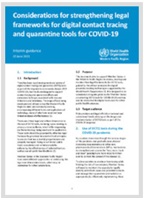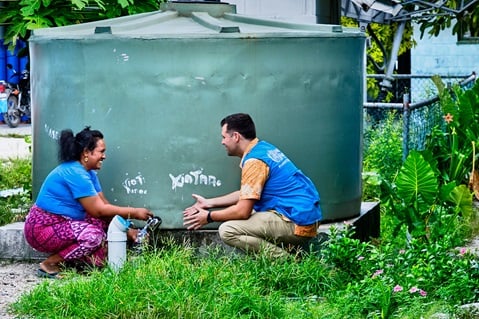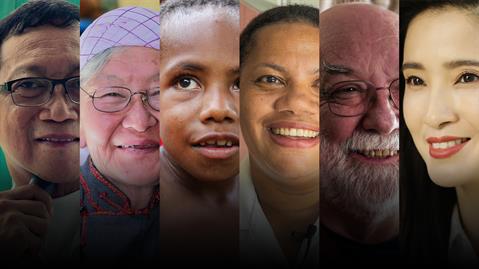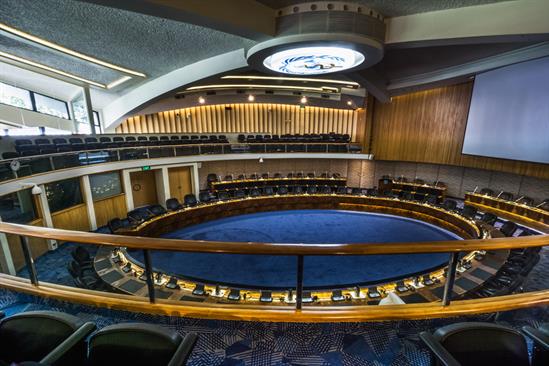Climate Change
Health-care waste management is a critical aspect of health-care systems, crucial for public health and environmental sustainability. This report provides...
Annual report 2021: WHO Asia-Pacific Centre for Environment and Health in the Western Pacific Region...
The WHO Asia-Pacific Centre for Environment and Health in the Western Pacific Region (ACE), located in Seoul, Republic of Korea, has published...
Climate change and health in the Western Pacific Region : synthesis of evidence, profiles of selected...
The Western Pacific Region, which includes many low-lying Pacific island countries and areas, is especially vulnerable to climate change, and the impact...
Human health and climate change in Pacific Island countries
The global community has had a “blind spot” concerning the extent of the risks posed by human-induced climate change to the well-being, health...
Health Facilities
Power outages: four tips to reduce food safety risks
Natural disasters and emergencies frequently cause power outages that can compromise the quality and safety of food. These flyers include tips to reduce...
WHO disability-inclusive health services training package: a companion to the Disability-inclusive health...
The WHO Disability-Inclusive Health Services Training Package is a companion to the “WHO Disability-Inclusive Health Services Toolkit: A resource...
Regional strategic framework for vaccine-preventable diseases and immunization in the Western Pacific...
The WHO’s Regional Committee for the Western Pacific endorsed the Regional Strategic Framework for Vaccine-Preventable Diseases (VPDs)...
Disability-inclusive health services toolkit : a resource for health facilities in the Western Pacific...
The United Nation Convention on the Rights of Persons with Disabilities upholds the rights of people with disabilities to access health services. The Disability-...
Disaster evacuation shelters in the context of COVID-19
The Western Pacific is the world’s most disaster-prone region. When a disaster occurs, people may need to seek accommodation in a disaster evacuation...
Primary Health Care
The Country Cooperation Strategy (CCS) is WHO’s strategic framework to guide the Organization’s work in and with a country. It responds to...
History as a partner in public health: a report of the foresight think tank on the history of pandemics
At the onset of the COVID-19 pandemic, the Data, Strategy and Innovation group of the WHO Regional Office for the Western Pacific collaborated with eight...
The Papua New Guinea–WHO Country Cooperation Strategy 2024–2028 describes how the World Health Organization (WHO) country office will support...
The Regional Framework to Shape a Health Workforce for the Future of the Western Pacific was adopted by Member States at the seventy-fourth session of...
Report of the Regional Director : the work of WHO in the Western Pacific Region, 1 July 2022 - 30 June...
Covering the period from July 2022 to June 2023, this Report highlights how WHO in the Western Pacific Region has worked to turn the hard lessons of the...
China-WHO country cooperation strategy 2022–2026
The World Health Organization (WHO) country cooperation strategy (CCS) is a strategic framework to guide the Organization’s work in and with...
Building sustainable primary health care in the Lao People's Democratic Republic through community engagement...
Despite recent progress, inequities remain for health outcomes in the Lao People’s Democratic Republic, especially in terms of maternal and child...
The refugee and asylum-seeking populations in Malaysia face several psychosocial stressors, including the inability to secure safe and stable employment,...
Regional Framework on the Future of Primary Health Care (PHC) was adopted by Member States at the seventy-third session of the Regional Committee for the...
Regional action framework for noncommunicable disease prevention and control in the Western Pacific
The Regional Action Framework for Noncommunicable Disease Prevention and Control provides a unified vision of objectives and recommended actions to combat...
Health and economic impacts of antimicrobial resistance in the Western Pacific Region, 2020–2030
Antimicrobial resistance (AMR) is projected to cause substantial morbidity and mortality in the World Health Organization (WHO) Western Pacific Region...
Responding to outbreaks of antimicrobial-resistant pathogens in health-care facilities: guidance for...
Responding to Outbreaks of Antimicrobial-resistant Pathogens in Health-care Facilities: Guidance for the Western Pacific Region is developed following...
Outcome of the Fourteenth Pacific Health Ministers Meeting, virtual meeting hosted by Tuvalu, 22-24 March...
The Fourteenth Pacific Health Ministers Meeting was hosted by Tuvalu on 22–24 March 2022 with support from the World Health Organization (WHO)...
The Early Essential Newborn Care Pocket Guide was developed by the WHO Regional Office for the Western Pacific for introducing and scaling-up Early Essential...
Stocktaking to advance implementation of For the Future: Towards the Healthiest and Safest Region
This information document summarizes the stocktaking exercises conducted to articulate the progress of For the Future, our vision in the Western Pacific...
Traditional and Complementary Medicine is widely practised and relied upon by a significant proportion of the population in many countries and areas in...
A toolkit on how to implement social prescribing
Social prescribing is a means of connecting patients to a range of non-clinical services in the community to improve their health and well-being. It builds...
The Global School-based Student Health Survey (GSHS) is designed to help countries measure and assess behavioural risk factors among students...
Antimicrobial consumption in the WHO Western Pacific Region: early implementation of the Western Pacific...
The overuse and misuse of antimicrobials contribute to the emergence of antimicrobial resistance. WHO established the Western Pacific Regional Antimicrobial...
The health-related Sustainable Development Goals: progress report of the Western Pacific Region, 2020
The new regional vision paper “For the Future: Towards the Healthiest and Safest Region” raised four thematic priorities for strategically...
It takes a village: a television and radio series on maternal and newborn health: pilot episode measurement,...
Papua New Guinea has one of highest maternal mortality rates in the world. To reverse trends, the World Health Organization (WHO) worked with...
Action framework for safe and affordable surgery in the Western Pacific Region (2021-2030)
The Action Framework for Safe and Affordable Surgery in the Western Pacific Region (2021-2030) was adopted by Member States at the seventy-first...
Enhancing acceptance and demand for vaccination in the Western Pacific Region : a guide for programme...
Vaccine hesitancy was one of the top 10 global health threats cited by the World Health Organization (WHO) for 2019. There is a risk of underutilization...
Celebrating women's voices in the Western Pacific Region : leadership, diversity and health
Celebrating Women's Voices in the Western Pacific Region highlights women leading change in health and development across the Region. The report demonstrates...
Monitoring progress towards the vision of healthy islands in the Pacific : second progress report 2019
At the first Pacific Health Ministers Meeting (PHMM) in 1995, ministers declared their vision of Healthy Islands. Findings from the 20-year review...
This document, Vital Roles of Nurses and Midwives in the Western Pacific Region, showcases some of the key contributions of nurses and midwives towards...
Oral Health
The school is one of the best places where health education and health promotion can take place. Children spend a great deal of time in this setting....
Health Financing
Monitoring financial protection and utilization of health services in Mongolia: 2009-2018
"Monitoring financial protection and utilization of health services in Mongolia 2009-2018" is based on national representative household socioeconomic...
Increasing equity in health service access and financing : health strategy, policy achievements and new...
This policy note is based on a draft brief presented and discussed at the policy dialogue event in Cambodia on 9 October 2015. The event was sponsored...
Digital Health
Regional action framework on communication for health: a vision for using communication to improve public...
Strategic communication is at the heart of public health and more important than ever in the digital age. Using communication strategically requires expertise,...
Guidance on establishing national and local AMR surveillance systems in the Western Pacific Region
Antimicrobial resistance (AMR) is impacting our health, economies and development. Up to 5.2 million people may die because of resistant bacterial...
Addressing trust through digitally enabled community engagement approaches in HIV/AIDS
The coronavirus disease (COVID-19) pandemic caused severe disruptions in HIV/AIDS programming and service delivery, negatively impacting Cambodia’s...
The coronavirus disease (COVID-19) pandemic has exposed inequities and service delivery gaps in national and global health systems. These weaknesses...
Data management competency framework
The effective use of data in the management and delivery of public health services has long been understood as critical. The Data Management Competency...
Hypothesis-driven approach for problem-solving in the context of global public health
The hypothesis-driven approach is a problem-solving method that is necessary at WHO because the environment around us is changing rapidly. WHO needs a...
Five keys for safer traditional food markets: risk mitigation in traditional food markets in the Asia-Pacific...
Traditional food markets play important economic, cultural, and social role and are sources of livelihood for millions of people in urban and rural areas....
Storytelling handbook
Storytelling is both a science and an art. Stories are in our nature. Our brains are wired for them. For at least 40 000 years – dating...
Outcome of the Fourteenth Pacific Health Ministers Meeting, virtual meeting hosted by Tuvalu, 22-24 March...
The Fourteenth Pacific Health Ministers Meeting was hosted by Tuvalu on 22–24 March 2022 with support from the World Health Organization (WHO)...
Stocktaking to advance implementation of For the Future: Towards the Healthiest and Safest Region
This information document summarizes the stocktaking exercises conducted to articulate the progress of For the Future, our vision in the Western Pacific...
Communication for Health in the WHO Western Pacific Region
Communication for Health (C4H) is a priority for the implementation of For the Future – our shared vision for WHO’s work with Member...
The use of digital technology as part of the response to the coronavirus disease 2019 (COVID-19) highlights its potential to accelerate the achievement...
The Health Futures Forum: Shaping the Future of Health, hosted by WHO on 24–26 August 2021, was a landmark event. The Forum encouraged participants...

Considerations for strengthening legal frameworks for digital contact tracing and quarantine tools for...
There has been rapid development and uptake of digital contact tracing and quarantine (DCTQ) tools as part of the response to coronavirus disease...
Progress on the prevention and control of noncommunicable diseases in the Western Pacific Region: country...
Progress on Prevention and Control of Noncommunicable Diseases in the Western Pacific Region: Country Capacity Survey 2019 provides an update of Member...
Implementing telemedicine services during COVID-19 : guiding principles and considerations for a stepwise...
Telemedicine is a key strategy to maintain and complement health service that’s been disrupted in the COVID-19 pandemic. However, the design and...
This Assistive Technology (AT) Procurement Study explores the current challenges with and strategies to strengthening the procurement of appropriate...
Health Security
Endorsed by Member States in 2023, the Asia Pacific Health Security Action Framework (APHSAF) is designed to engage multisectoral actors in health...
Asia Pacific Health Security Action Framework
Public health emergencies, including pandemics, highlight the need for health systems and services that are prepared, resilient and ready to respond to...
Regional health innovation strategy for the Western Pacific
The Regional Health Innovation Strategy for the Western Pacific outlines a vision and recommends key actions for governments to leverage health innovations...
Framework for national surveillance and control plans for Aedes vectors in the Pacific
Populations in Pacific island countries and areas (PICs) remain vulnerable to outbreaks of diseases carried by Aedes mosquitoes for which there...
Five keys for safer traditional food markets: risk mitigation in traditional food markets in the Asia-Pacific...
Traditional food markets play important economic, cultural, and social role and are sources of livelihood for millions of people in urban and rural areas....
Operational guide: use of referral laboratories for the analysis of foodborne hazards in the Pacific
The Operational guide: use of referral laboratories for the analysis of foodborne hazards in the Pacific aims to strengthen the food analysis capacity...
Implementing the nurturing care framework: resources
WHO and UNICEF have developed a range of tools to facilitate the implementation of the Nurturing care framework. The brochure provides an overview of the...
Guidelines for the surveillance of congenital rubella syndrome in the Western Pacific Region
Congenital rubella syndrome (CRS), a constellation of birth defects, can result from rubella cases among susceptible pregnant women. To achieve...
Noncommunicable Diseases
Care for infants and young children: implementation review and planning guide: care for infants and children...
Frontline health workers remain the most effective resource for managing sick children, screening them for preventable problems, and providing critical...
Preventing unplanned pregnancies: implementation review and planning guide: outpatient family planning...
Frontline health workers are critical to the provision of effective counselling about family planning and support to women on the correct use of contraceptives....
The pathway to strengthen multisectoral collaboration at the human-animal-environmental interface (HAI) aims to improve health security through...
Strategic framework for the comprehensive prevention and control of cervical cancer in the Western Pacific...
The Western Pacific Region accounts for one-fourth of the global cervical cancer burden, and approximately 90% of that burden is in lower-middle-income...
Facilitators’ guide to the train-the-trainers workshop for Pacific faith-based organizations and local...
In 2016, following the WHO publication “Healthy Islands: Best Practice in Health Promotion in the Pacific” resource, there has been extensive...
Participants’ workbook for the train-the-trainers workshop for Pacific faith-based organizations and...
In 2016, following the WHO publication “Healthy Islands: Best Practice in Health Promotion in the Pacific” resource, there has been extensive...
Pacific tobacco industry interference index: a tool for monitoring the types and extent of tobacco industry...
Information regarding the implementation of the recommendations of the Article 5.3 Guidelines across the Pacific island countries is limited and has...
Global reproductive, maternal, newborn, child and adolescent health policy survey: report for the Western...
The Global Reproductive, Maternal, Newborn, Child and Adolescent Health Policy Survey Report for the Western Pacific Region 2020 was developed by the WHO...
Third biennial progress report: 2018-2020 (Action Plan for Health Newborn Infants in the Western Pacific...
The Third Biennial Meeting on Accelerating Progress in early essential newborn care (EENC): Synergies with Hospital Quality and Patient Safety...
The Regional Status Report on Drowning in the Western Pacific presents findings from the first assessment of drowning prevention in the Region. The report...
Progress on the prevention and control of noncommunicable diseases in the Western Pacific Region: country...
Progress on Prevention and Control of Noncommunicable Diseases in the Western Pacific Region: Country Capacity Survey 2019 provides an update of Member...
Reaching the unreached
Electronic cigarettes (E-cigarettes)
E-cigarettes are the most common type of electronic nicotine delivery systems (ENDS) and electronic non-nicotine delivery systems (ENNDS). They heat a...
The Human Resources for Health Country Profiles: Kingdom of Tonga provides a comprehensive analysis of the health workforce in Tonga based on the latest...
The Regional Framework for Reaching the Unreached in the Western Pacific (2022–2030) aims to support Member States in transforming their health...
During the coronavirus disease (COVID-19) pandemic, public health measures in Malaysia to control the spread of the virus – such as lockdowns,...
Good mental health is integral to the well-being of everyone. Promoting and protecting mental health is also critical to a well-functioning society. The...
Field guide for preparedness and response to diphtheria outbreaks in the Western Pacific Region
Due to high routine vaccination coverage, overall counts of diphtheria case have significantly declined in the Western Pacific Region recently. However,...
Regional framework on nurturing resilient and healthy future generations in the Western Pacific
The Regional Framework on Nurturing Resilient and Healthy Future Generations in the Western Pacific recognised that investing in health and schools offers...
The Western Pacific Regional Road Map for COVID-19 Vaccination Response 2021-2022 aims: (1) to summarize the vaccination response and progress...
Infection prevention and control during transfer and transport of patients with suspected or confirmed...
Patients with suspected coronavirus disease 2019 (COVID-19) can infect others at any time, including during transfer and transport. Ensuring the proper...
The Western Pacific Regional Framework to End TB (2021–2030) was developed at the request of and in consultation with the Member States in the...
The regional TB Framework to End TB 2021-2030 was endorsed by the World Health Organization Regional Committee for the Western Pacific in 2021. The framework...
Considerations for COVID-19 surveillance for vulnerable populations
Population groups living in vulnerable situations, or vulnerable populations, may be at increased risk of contracting COVID-19 as a result of the structural...
This document summarizes current evidence on TB outbreaks in schools and contextualizes the information within the Western Pacific Region. Case studies...
This report presents all available historical data for all countries and areas of the Western Pacific Region for last 35 years from 1983 to 2018, together...
As populations across the Western Pacific Region continue to age, the number of people living with dementia, as well as the overall burden associated with...
Infection prevention and control considerations for handling cargo in the context of COVID-19
This document provides interim guidance on infection prevention and control measures for all those who are involved with handling cargo during the COVID-19...
Regional action plan for tobacco control in the Western Pacific (2020-2030) : working towards a healthy,...
Tobacco kills more than 3 million people a year in the Western Pacific Region. Tobacco's toll on the health of the population in the Region translates...
WP Regional Action Plans and Frameworks
The Pacific Islands–WHO Multi-country Cooperation Strategy 2024–2029, or MCCS, developed by the World Health Organization (WHO) through a...
The Country Cooperation Strategy (CCS) is WHO’s strategic framework to guide the Organization’s work in and with a country. It responds to...
The Papua New Guinea–WHO Country Cooperation Strategy 2024–2028 describes how the World Health Organization (WHO) country office will support...
This country cooperation strategy (CCS) outlines how the World Health Organization (WHO) will work with the Lao People’s Democratic Republic over...
China-WHO country cooperation strategy 2022–2026
The World Health Organization (WHO) country cooperation strategy (CCS) is a strategic framework to guide the Organization’s work in and with...




